|
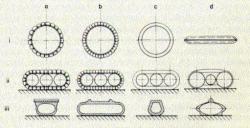
|
1 - Four categories of tire tracks are from left to right : chain, belt, ring and tube type.
|
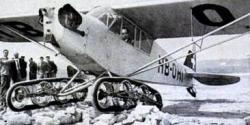
|
2 - Piper Aircraft equipped with tracked landing gear of G. Bonmartini.
|
|
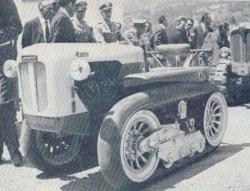
|
3 - Caterpillar 'Castoro' equipped with Bonmartini tubular caterpillars of G. Bonmartini in 1962.
http://vieilles-soupapes.grafbb.com/t16058-lombardini-castoro-a-chenilles-pneumatiques
|
|
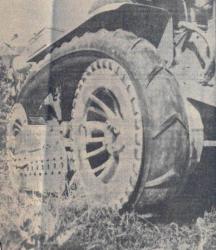
|
4 - Close-up view on the Bonmartini tubular caterpillar of the modified 'Castoro' tractor. In addition to the smooth ride, it would have allowed traffic on roads. Pict from newspaper : L'Argus, 1964 01 23
|
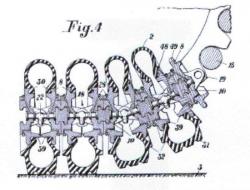
|
5 - Side view of a patent of deformable multi-tires track of G. Bonmartini in 1964: each tire flange was articulated on the following. Patent. Drawing from review 'Ingénieurs de l'Automobile', 1966 05.
|
|
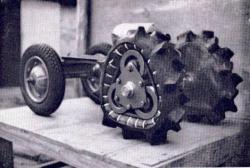
|
6 - Model of the pneumatic half-caterpillar H. Okada. The slip decreased from 37% with a wheel at 9.5% with half-caterpillar. Pict from Journal of Terramechanics, 1966, Vol. 3, N° 1, Pergamon Press, Elsevier.
|
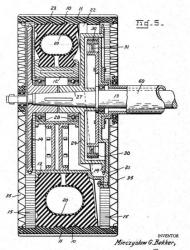
|
7 - Mobile Support of M. G. Bekker, side view. US2652290 patent.
|
|
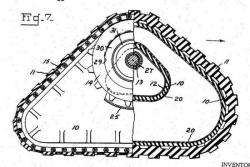
|
8 - Mobile Support of M. G. Bekker sectional view. The mechanism should bathe in oil and the side seals should ensure waterproofness. US2652290 patent.
|
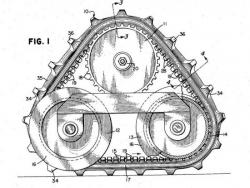
|
9 - D. O. Yoe proposed in 1963 a patent for triangular pneumatic caterpillar. Today this shape commonly exists on tracks. US3072443 patent.
|
|
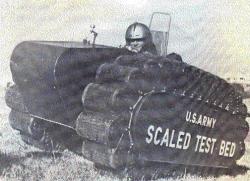
|
10 - The Scaled Test Bed, reduced prototype of the PATA, 1961. Pict J M M collection (from former Ling-Temco-Vought Inc.).
|
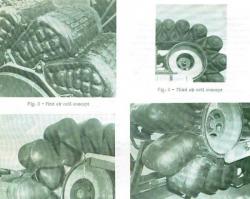
|
11 - It can be seen the different configurations of the caterpillar bags tested on the reduced scale model, the Scaled Test Bed. Pict from SAE paper 690152 : 'The Air-Cell Suspension System a Solution to Off-road Problems', 1969.
|
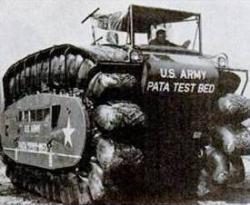
|
12 - The caterpillars of PATA (1965) occupied a respectable volume. The heat generated by the internal friction of the track warmed the cabin. Pict from review 'The Engineer', 1966 02 18.
|
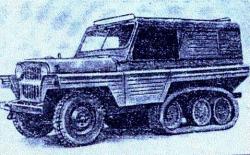
|
13 - Semi-tracked S-3M NAMI (1965) issued from a production vehicle encountered problems due to cooling transmission because the rear of the vehicle was heavier than the original wheels. Tracks brought a great smooth ride.
Pict from book of Alain Dupouy, Auto-éditeur : 'Les véhicules tout-terrain N° 11 Tome I'. Grenoble, 1995.
|
|

|
14 - The 0106 NAMI amphibious articulated tracked vehicle with tubular configuration tracks, which allowed good all-terrain performance, but the tracks logically proved insufficient for propulsion in water. Pict from http://www.off-road-drive.ru/archive/3/Prokol_spustila_gusenica.
|
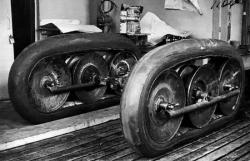
|
15 - One of four moving treads of NAMI 0106.
http://www.off-road-drive.ru/archive/3/Prokol_spustila_gusenica
|
|
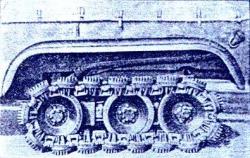
|
16 - UAZ-469 crawler 'Honeycomb' provided a better grip on the ground.
Pict from book of Alain Dupouy, Auto-éditeur : 'Les véhicules tout-terrain N° 11 Tome I'. 1995.
|
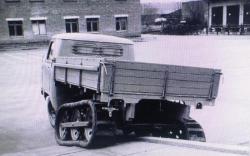
|
17 - Semi-tracked truck NAMI S-4. http://www.off-road-drive.ru/archive/3/Prokol_spustila_gusenica
|
|
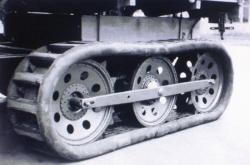
|
18 - Focus on the caterpillars of NAMI S-4. http://www.off-road-drive.ru/archive/3/Prokol_spustila_gusenica
|
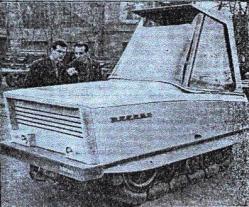
|
19 - The Evrika prototype tractor.
Pict from book of Alain Dupouy, Auto-éditeur : 'Les véhicules tout-terrain N° 11 Tome I'. 1995.
|
|
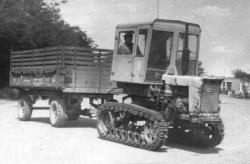
|
20 - T-54sPG tractor from Kishinev plant. Standard bands could be contiguous together to create tracks more or less wide.
Pict from book of Alain Dupouy, Auto-éditeur : 'Les véhicules tout-terrain N° 11 Tome I'. 1995.
|
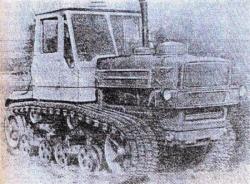
|
21 - T-150 Kharkov tractor has the same type of tracks that the T-54sPG.
Pict from book of Alain Dupouy, Auto-éditeur : 'Les véhicules tout-terrain N° 11 Tome I'. 1995.
|
|
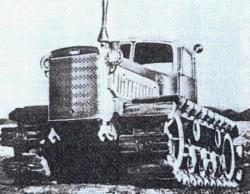
|
22 - DT-75 Kirovets tractor equipped with bags.
Pict from book of Alain Dupouy, Auto-éditeur : 'Les véhicules tout-terrain N° 11 Tome I'. 1995.
|
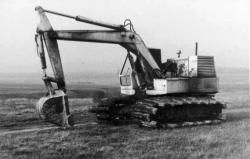
|
23 - Excavator E-4121 for emergency response in lackluster fields. Pict of the former site of www.nntu.sci-nnov.ru, of Nizhny Novgorod University.
|
|
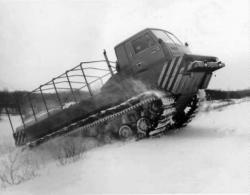
|
24 - STRPr6901-01, amphibious vehicle equipped with pneumatic studs. Pict of the former site of www.nntu.sci-nnov.ru, of Nizhny Novgorod University.
|
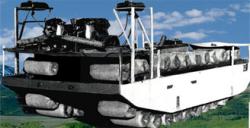
|
25 - The 0.5-VACT dates from the late 90s and uses the same concept as the PATA. http://www.msun.ru/res/www/Azovcev/tsvgrus.htm
|
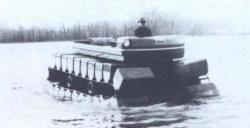
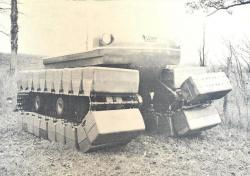
|
26 - Close up view of the Kristi KT-4 3/4 ton carrier, modified by Jered Industries, Birmingham, Michigan also called 'Water Walk' prototype. The Army constructed the floating bags.
Picture from book of Fred Crismon ‘US Military Tracked Vehicles’, Motorbook International Publishers & Wholesalers, 1992.
Picture below from the booklet RAVE I (Remote Area Vehicle Evaluation I at Pontiac, Michigan), US ATAC Research and Engineering Directorate, 29 Oct 1962.
See also the site :
history/
prototypes/
KT4JC/kt4jcgallery.asp
|
See the site :
history/
prototypes/
KT4JC/kt4jcgallery.asp
|
27 - The prototype Kristi KT-4 without its bags was designed to remain horizontal using levers and jacks. It is worth mentioning that all vehicles constructed by this brand were self-leveling through a patented mechanism on a slope smaller than 15 °. 180 units of this brand get out the assembly lines between 1953 and 1968.
Text of pictures 27 comes from the site :
|
|
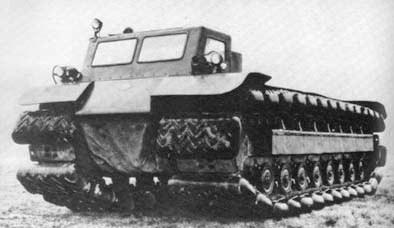
|
28 - The 'Vehicles to cross the marshes' built circa 1942 was 7 m long with an empty weight of 8.25 tons and a diesel engine 130 hp providing a maximum speed of 19 km / h in mud, 8 on water, 35 on hard ground. This is the larger of the two prototypes produced. http://www.strange-mecha.com/vehicle/track/scv.htm
|
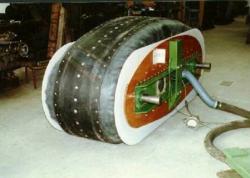
|
29 - The prototype of air-cushion track of W. R. Bertelsen in 1987. The key to this track was slippery seal between fixed parts and moving parts. With a pressure of 0.5 kg/cm2, the problem seemed to have been resolved to travel off-road in mud, sand or rocks.
|
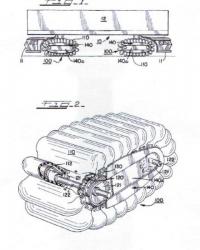
|
30 - Patent of air tracks with compartments W. R. Bertelsen 1985. It looked like the tracks of PATA. US4530545.
|
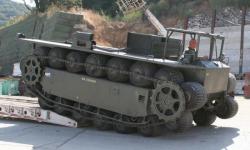
|
31 - Airoll of a private museum in Northern California. From site com-central.net
|
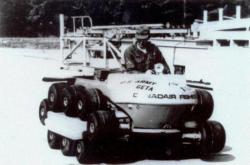
|
32 - Canadair-Fisher, a small high-performance ATV in 1963-1964, whose two copies were built. What did they become ? Collection J M Maclou (from Fred Crismon).
|
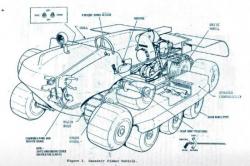
|
33 – Sectional view of Canadair Fisher : It can be seen well the wheels with tires causing a belt movement on which are fixed the axles of low pressure tires. Drawing from 'Military Potential Test of Canadair Fisher Vehicle, NTIS, Dec 1967.
|

|
34 - Pneumatic caterpillar with rollers of W. W. Cushman of January 6, 1959. US2867480 patent.
|
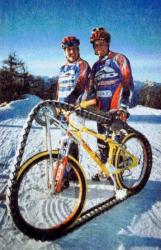
|
35 - Tracked bicycle of Patrick Carn to move in snow or sand : it was surely better downhill. From 'Le Livre des Inventions', by Valérie-Anne Giscard d'Estaing, 1999.
|

|
36 - Principle of the toroïdal drive in 2005. The exterior of an inverted torus turns on itself. Surprising ! http://evgars.com/tore_tranport.htm
|
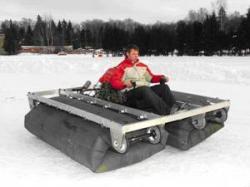
|
37 - Prototype of vehicle with toroïdal propulsion by Shihirin Valery : research continues. http://www.elastoneering.com/mukhtar.htm
|
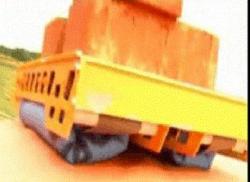
|
38 – Scale model of a similar vehicle. http://evgars.com/tore_tranport.htm
|
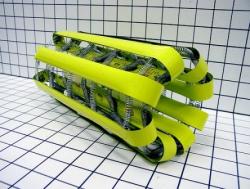 |
WSL, Whole Skin Locomotion robot, 2008, of Romela, University of Virginia, inspired by Amoeba locomotion where outer ectoplasm moves around endoplasm causing forward movement of the whole. It can squeeze through small spaces.
|
| |
|








































 Français
Français
 English
English
 Español
Español
 Italiano
Italiano
 Deutsch
Deutsch
 Nederlands
Nederlands
 Portuguesa
Portuguesa